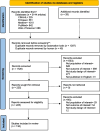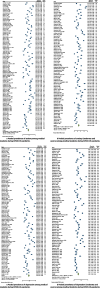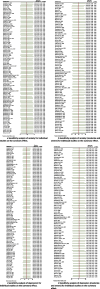Global prevalence of anxiety and depression among medical students during the COVID-19 pandemic: a systematic review and meta-analysis
- PMID: 38858700
- PMCID: PMC11163725
- DOI: 10.1186/s40359-024-01838-y
Global prevalence of anxiety and depression among medical students during the COVID-19 pandemic: a systematic review and meta-analysis
Abstract
Purpose: As future physicians, medical students have experienced tremendous pressure during the ongoing COVID-19 pandemic, which is associated with a high risk of depression and anxiety. We aimed to investigate an overview of the prevalence of anxiety and depression among medical students in various countries during the global COVID-19 pandemic, and discuss associated stressors.
Methods: We systematically searched CINAHL, EMBASE, MEDLINE, PubMed, and Web of Science for relevant articles from December 1, 2019 to March 15, 2023. We performed meta-analysis using a random-effects model with REML method to calculate the pooled prevalence of anxiety and depression. Begg's and Egger's tests were used to identify the potential risk of publication bias. Meta-regression was used to explore potential sources of heterogeneity.
Results: We identified 130 studies reporting anxiety and depression among 132,068 medical students during the COVID-19 pandemic. Eight screening tools were identified for anxiety and six for depression. The pooled prevalence of mental health outcomes for anxiety and depression was 45% (95% confidence interval [CI], 40%-49%) and 48% (95% CI, 43%-52%), respectively. The pooled prevalence of mental health outcomes for moderate and severe anxiety and moderate and severe depression was 28% (95% CI, 24%-32%) and 30% (95% CI, 26%-35%), respectively. There was high heterogeneity between studies, with I2 ranging from 99.58%-99.66%. Continent and survey date were included in the meta-regression model. The results of meta-regression revealed that medical students in Asia had a lower prevalence of anxiety, and depression than those in other regions. The survey date (from February to June, 2020) showed a significantly positive correlation with the prevalence of anxiety and depression.
Conclusions: We demonstrated the global prevalence of anxiety and depression among medical students during the COVID-19 pandemic. The data highlight that medical students worldwide are at high risk of experiencing anxiety and depression. The reported stressors can be categorized into personal, academic, environmental and cultural, and pandemic factors. Schools and institutions should ensure optimal alternative learning environments for uninterrupted provision of medical education. The appropriate authorities should prioritize the provision of adequate protection for medical students and establish policies to promote new methods of training and education during a disaster, such as via distance learning.
Keywords: Anxiety; COVID-19; Depression; Medical students; Prevalence.
© 2024. The Author(s).
Conflict of interest statement
The authors declare that they have no competing interests.
Figures




Similar articles
-
Anxiety and Depression Disorders in Undergraduate Medical Students During the COVID-19 Pandemic: An Integrative Literature Review.Int J Environ Res Public Health. 2024 Dec 3;21(12):1620. doi: 10.3390/ijerph21121620. Int J Environ Res Public Health. 2024. PMID: 39767461 Free PMC article. Review.
-
Prevalence of depression among medical students during the COVID-19 pandemic. A systematic review and meta-analysis.Rev Med Chil. 2021 Nov;149(11):1579-1588. doi: 10.4067/S0034-98872021001101579. Rev Med Chil. 2021. PMID: 35735320
-
Prevalence of anxiety symptom and depressive symptom among college students during COVID-19 pandemic: A meta-analysis.J Affect Disord. 2021 Sep 1;292:242-254. doi: 10.1016/j.jad.2021.05.109. Epub 2021 Jun 4. J Affect Disord. 2021. PMID: 34134022 Free PMC article.
-
Prevalence of psychological problems among caregivers of children and adolescents with neurodevelopmental disorders during the COVID-19 pandemic: A meta-analysis and systematic review.Res Dev Disabil. 2023 Dec;143:104632. doi: 10.1016/j.ridd.2023.104632. Epub 2023 Nov 16. Res Dev Disabil. 2023. PMID: 37976983
-
Stress, anxiety, depression and sleep disturbance among healthcare professional during the COVID-19 pandemic: An umbrella review of 72 meta-analyses.PLoS One. 2024 May 9;19(5):e0302597. doi: 10.1371/journal.pone.0302597. eCollection 2024. PLoS One. 2024. PMID: 38722888 Free PMC article.
Cited by
-
Sleep Quality and Mental Health Among Medical Students: A Cross-Sectional Study.J Clin Med. 2025 Mar 26;14(7):2274. doi: 10.3390/jcm14072274. J Clin Med. 2025. PMID: 40217724 Free PMC article.
-
Association of chronic stress during studies with depressive symptoms 10 years later.Sci Rep. 2025 Jan 18;15(1):2379. doi: 10.1038/s41598-025-85311-9. Sci Rep. 2025. PMID: 39827282 Free PMC article.
-
Psychological well-being and academic performance of Ukrainian medical students under the burden of war: a cross-sectional study.Front Public Health. 2025 Jan 6;12:1457026. doi: 10.3389/fpubh.2024.1457026. eCollection 2024. Front Public Health. 2025. PMID: 39835319 Free PMC article.
-
Anxiety and Depression Disorders in Undergraduate Medical Students During the COVID-19 Pandemic: An Integrative Literature Review.Int J Environ Res Public Health. 2024 Dec 3;21(12):1620. doi: 10.3390/ijerph21121620. Int J Environ Res Public Health. 2024. PMID: 39767461 Free PMC article. Review.
-
Construction workers' depression, anxiety, stress, and risk factors in China: a cross-sectional study.J Glob Health. 2025 Jul 21;15:04167. doi: 10.7189/jogh.15.04167. J Glob Health. 2025. PMID: 40689732 Free PMC article.
References
-
- WHO Director-General's opening remarks at the media briefing on COVID-19. World Health Organization. 2020. https://www.who.int/director-general/speeches/detail/who-director-genera.... Accessed 17 Nov 2021.
-
- Coronavirus Disease (COVID-19) Situation Dashboard. World Health Organization. 2024. https://covid19.who.int/. Accessed 31 Mar 2024.
Publication types
MeSH terms
Grants and funding
LinkOut - more resources
Full Text Sources
Medical
Research Materials

